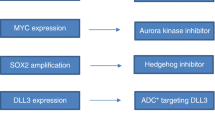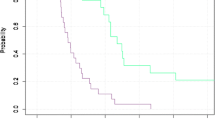Abstract
Lung cancer is epidemic and lethal throughout the world. Overall survival is estimated to be 13% at 5 years despite treatment. The use of chemotherapy in small-cell lung cancer (SCLC) is established, but it is less active against non-SCLC (NSCLC). Since 98% of SCLC cases are associated with heavy smoking and present at a median age of 60–65 years, the application of dose-intensive therapy to lung cancer patients may be complicated by underlying smoking-related comorbidity and an enhanced risk for secondary smoking-related malignancies. The strategies of intensifying induction therapy, multicycle dose-intensive combination therapies, chest radiotherapy, and stem cell purging for both SCLC and NSCLC are discussed herein. Limited data regarding high-dose therapy for NSCLC have been reported. In SCLC, excellent and immediate palliation is achieved through the use of combination chemotherapy. However, by 2 years, only 20–40% of limited-disease- (LD) and <5% of extensive-disease stage (ED) patients remain alive. Regimens developed using the many established agents produce similar short- and long-term outcomes, an observation that suggests that many of our systemic agents eradicate the same tumor subpopulation but fail to abolish a central core of tumor stem cells, presumably enriched for heterogeneous in vivo resistance mechanisms. The identification of these minimal residual tumor (MRT) cells and systematic evaluation of their biologic characteristics may guide strategies to target these cells specifically; such strategies may include modification of chemotherapy, tumor vaccination, or other forms of biologic therapy, such as replacement of RB, 3p, and/or p53 function; interference with autocrine or paracrine growth loops; or immunologic therapy [interleukin (IL)-2, IL-12, immunotoxins, and tumor vaccines], which would be most effective in the setting of MRT. To this end the detection of heterogeneity and analysis of patterns of coexpression of various markers form the thrust of our MRT detection program. At the Dana-Farber Cancer Institute and Beth Israel Hospital we performed stem-cell autografts in >40 patients with LD SCLC and >25 patients with ED SCLC who were in first response to conventional-dose therapy comprising high-dose combination alkylating agents. Approximately 80% of our patients were in or near complete response after initial chemotherapy. At a minimal follow-up of 23 months (to as long as 10 years) after completion of high-dose chemotherapy in our original trial, 52% of the patients remain disease-free. Of the ED or extrapulmonary patients, approximately 20% remain progression-free at >2 years after high-dose therapy. Local regional recurrence represents about 50% of all relapses. Thus, the roles of thoracic radiation dose intensity and purification of stem-cell autografts are being evaluated in ongoing trials. It is hoped that a cooperative phase III trial testing the concept of dose intensification will begin soon.
Similar content being viewed by others
Author information
Authors and Affiliations
Rights and permissions
About this article
Cite this article
Elias, A. Dose-intensive therapy in lung cancer. Cancer Chemother Pharmacol 40 (Suppl 1), S64–S69 (1997). https://doi.org/10.1007/s002800051064
Issue Date:
DOI: https://doi.org/10.1007/s002800051064




